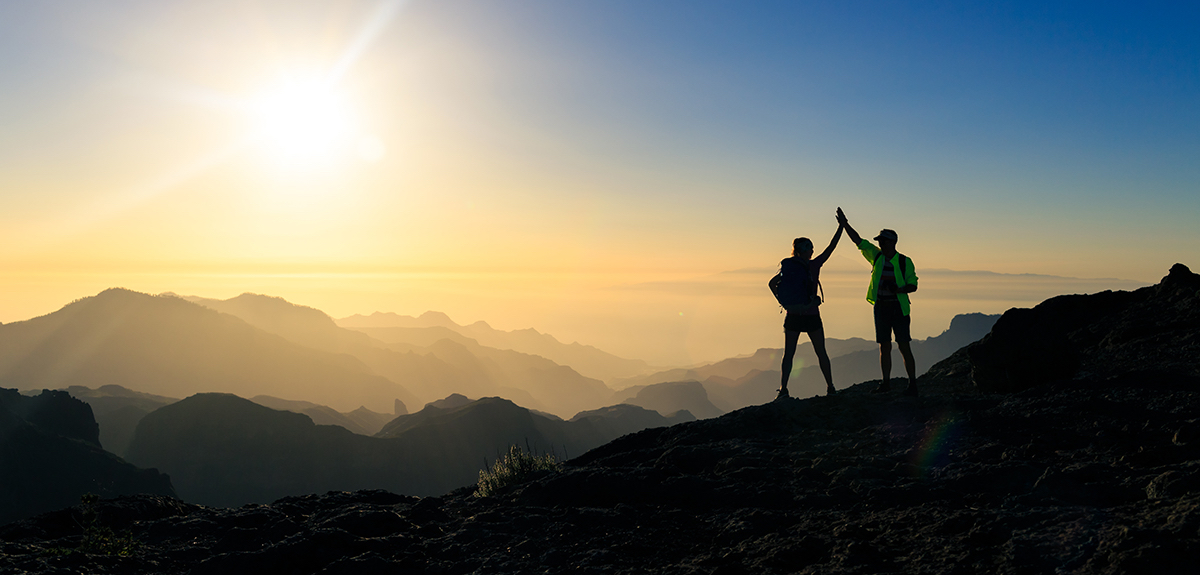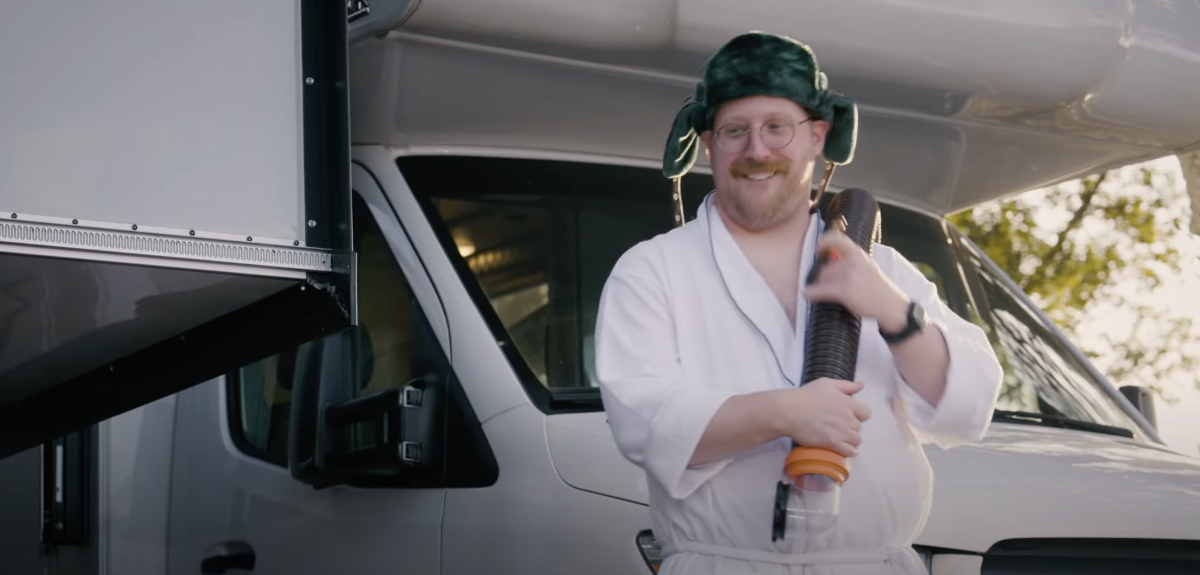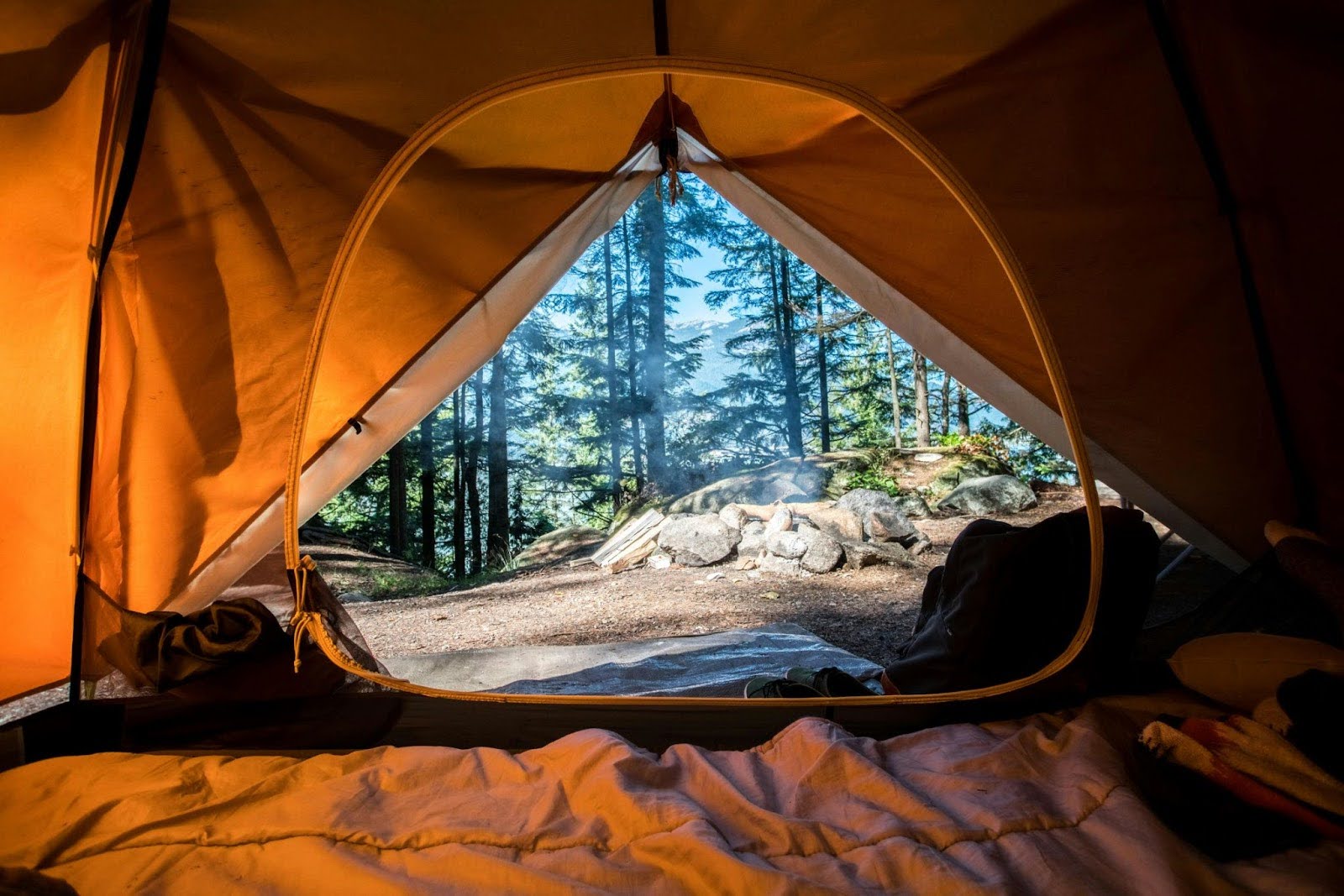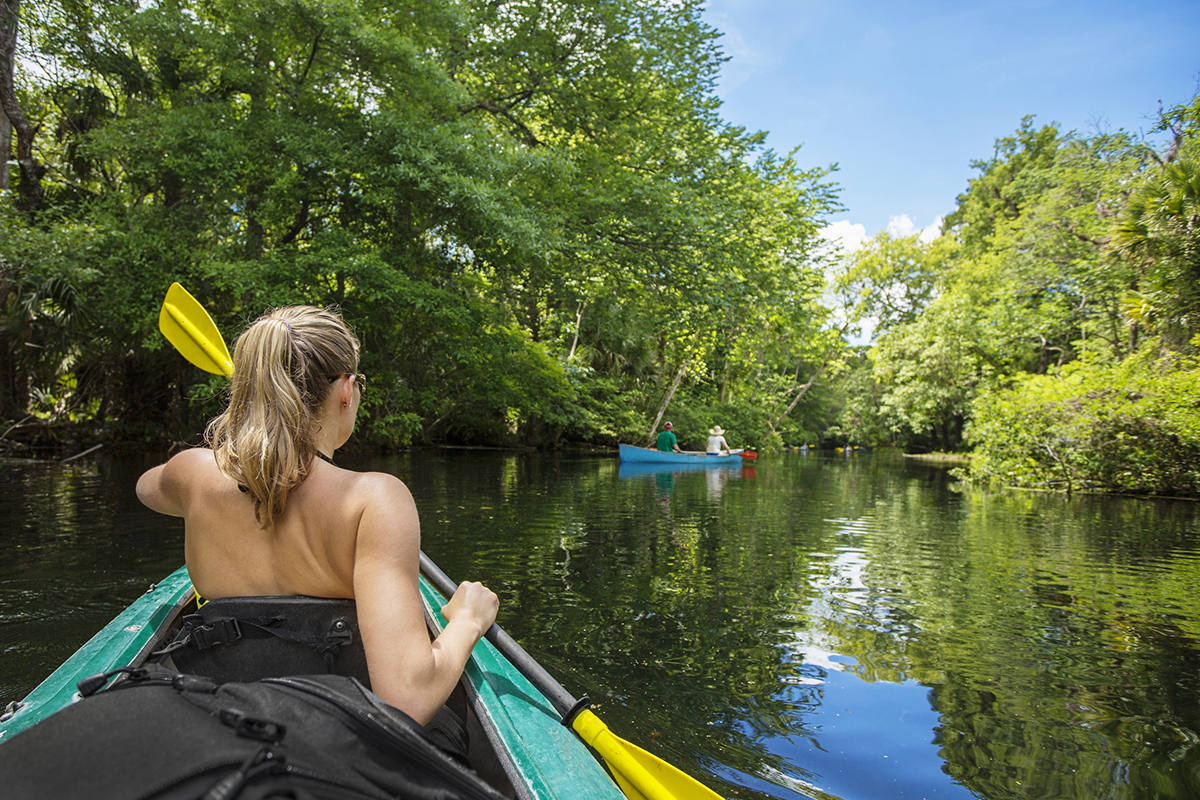RVing the Alaska Marine Highway System
Image Caption:
Imagine taking a nearly 3,000-mile RV trip yet driving only 800 miles. Picture a journey that allows you to see regions otherwise inaccessible to RVs. Now envision a tour filled with breathtaking scenery, historic towns and captivating wildlife, including seeing whales and eagles up close. Welcome to RVing via the Alaska Marine Highway System (AMHS), aka the Alaska ferry.
Last summer photographer Anne Weaver and I traveled through the Pacific Northwest’s gorgeous Inside Passage on the Alaska ferry with a Pleasure-Way Class B motorhome. It was convenient, wildly fun and oh-so relaxing.
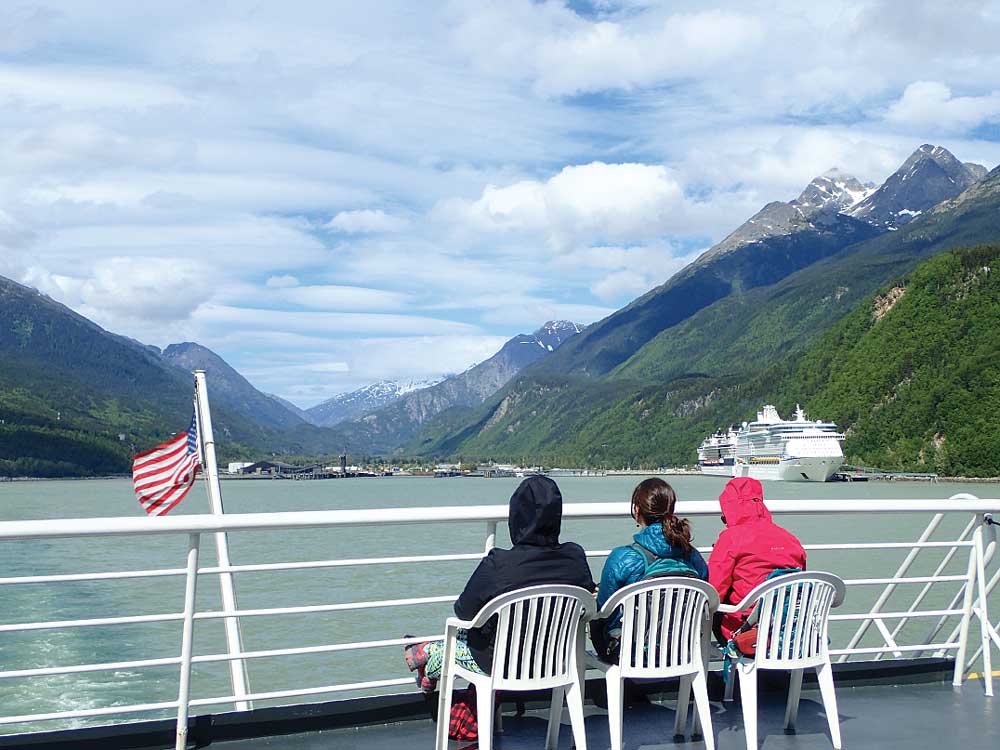
On the northbound route from Bellingham, Washington, ferry-goers sit back in deck chairs and drink in the scenery of the Inside Passage. Photos by Anne Weaver
We made plans to stop for a few days in Ketchikan and Juneau, two towns inaccessible by road, as well as Skagway, a favorite launch point for RVers to Denali National Park and the interior. And while some passengers bring sleeping bags and camp on the ferries’ tent decks or snooze in chairs, we reserved a snug cabin with a private bath.
Boarding in Bellingham
Bellingham, Washington, is the Alaska ferry’s southern terminus. We park in the loading line and walk to the cute-as-a-button Fairhaven district, filled with historic brick buildings, cafés and boutiques.
Soon, we’re boarding the 418-foot-long MV Columbia, the system’s largest vessel. Ferry staffers are experts at loading RVs and other large vehicles.
We overhear one driver say, “I don’t think I can back it up.” The crewman replies, “You’re not backing up. You’re following my directions.” The driver easily parks, and soon our rig and dozens of others are stowed.
Passengers are prohibited from sleeping in their vehicles, so we’ve booked a four-berth cabin. Besides bunks, the cabin offers a sink, shower, toilet, closet area and large window. We stash our gear and head up to an observation deck. As the ferry smoothly pulls away from the dock at 6 p.m., a harbor seal bobs in the water, and a great blue heron floats by.
The trip to Ketchikan is 38 hours, the longest leg. Since we sail all night, it feels brief. In the dining room, a spacious area with wraparound water views, we enjoy perfectly cooked Alaskan salmon dinners for $15 each. Then we stroll the decks, enjoying the long summer light. After taking in a free Spider-Man movie, I slip into my berth, and the ferry’s gentle rocking sends me into a deep sleep.
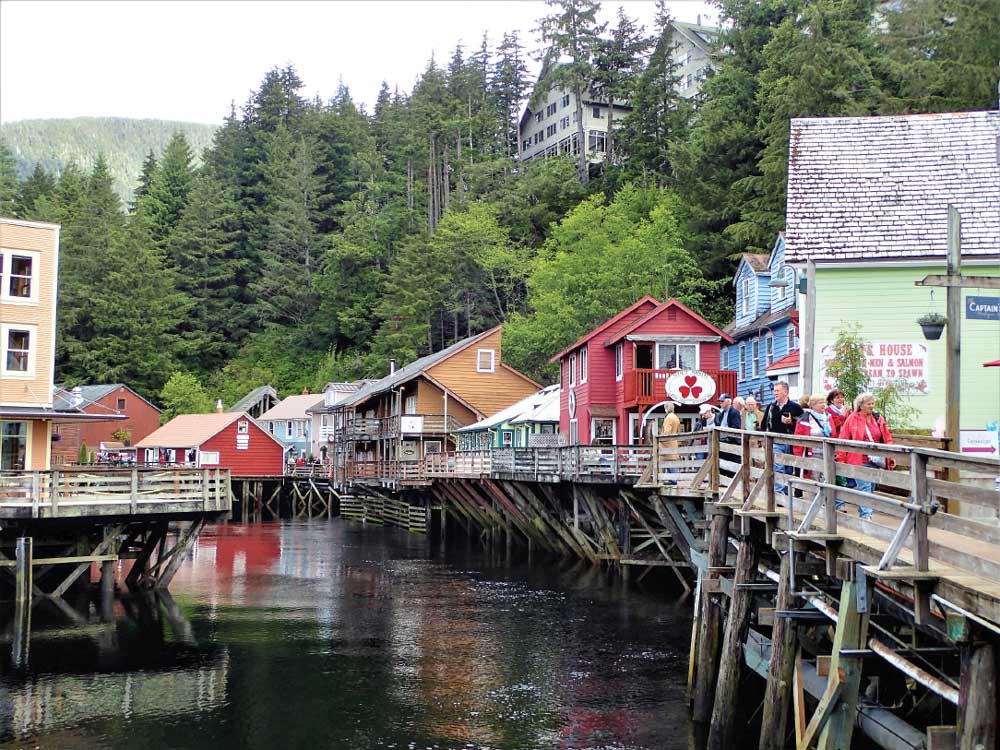
In Ketchikan, a picturesque boardwalk on wooden pilings leads to shops, restaurants and other attractions on Creek Street.
We wake to a sunny, cool day, perfect for sipping coffee in deck chairs. If you haven’t experienced the Inside Passage, it’s hard to imagine its incomparable beauty — soaring mountains covered with deep green forests, nearly vertical cliffs slashed with lacy waterfalls born in high-altitude snowfields, and green and blue waterways, alternately serene and roiling. There’s almost no development here, save for the occasional village or small town. It’s a vast wilderness that makes me breathe deeply.
Planning Your Trip on the Alaska Marine Highway System
Traveling via the Alaska Marine Highway System isn’t inexpensive, but the cost is offset by not putting wear and tear on your RV while cruising and saving on fuel and campsites. May through September is the peak season for ferry travel. Make reservations early on popular routes — some advise three to four months ahead, especially if you’re bringing your RV or want to book a cabin. AMHS reservation agents at 800-642-0066 can help plan an itinerary.
Landing in Ketchikan
Reaching Ketchikan at 7 a.m., we disembark with the Pleasure-Way and head to the Landing Restaurant and Hotel for delectable crab omelets. Our friend and Ketchikan resident, Patti, suggests we start downtown at the Southeast Alaska Discovery Center, a Forest Service exhibit exploring the area’s rainforest and other ecosystems. We check out historic photos and watch the video Discovering the Tongass about one of the last intact rainforests.
Three cruise ships are tied at the docks, so streets are bustling with tourists and tour buses. Ketchikan has always been a boomtown. Once it was timber and fish; now it’s adventuresome travelers.
We grab a walking-tour map at the visitor center and saunter along Ketchikan Creek’s wooden sidewalks to shops and historic buildings, including Dolly’s House, a 1919 bordello offering tours. Then we pop into Tongass Historical Museum and enjoy old-time photos and artifacts, including classic diving gear, fishing equipment and a 1904 Fresnel lighthouse lens.
After lunch, we head to Carlin Air for a tour of Misty Fjords National Monument, a vast wilderness of spectacular fjords, inlets and waterways. Our little plane feels Lilliputian in this land of giants. We fly over endless green forests and mossy swamps (muskegs), lakes and rivers.
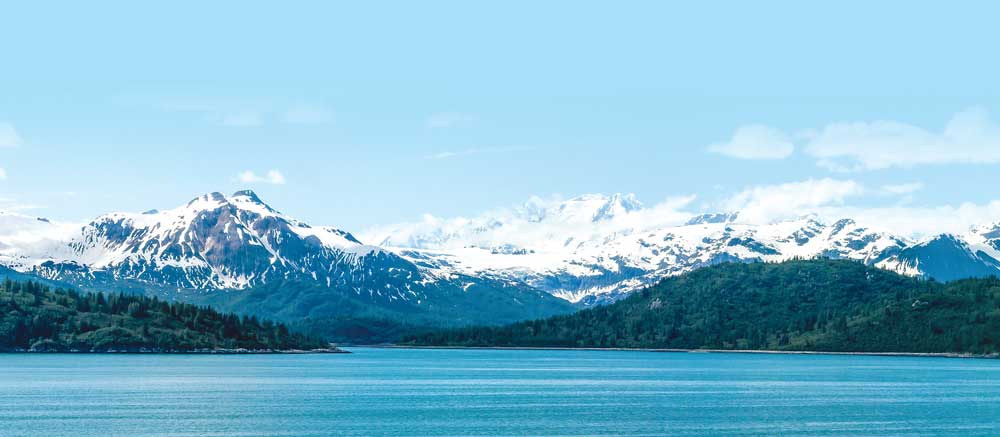
Weaving through hundreds of coastal islands in the Inside Passage, the Alaska ferry serves up spectacular views of snowcapped mountains.
We buzz Deep Canal and massive rock walls that plunge into secret valleys. Captain Jim banks the plane around a 1,000-foot waterfall that thunders into a misty pool.
Where to Camp In Alaska
JUNEAU
Spruce Meadow RV Park
KETCHIKAN
Clover Pass Resort
SKAGWAY
Pullen Creek RV Park
Finally, we fly over Behm Canal, the longest waterway in the Misties, and deplane onto a floating dock in Rudyerd Bay. We stand in this natural temple with the rush of a creek the only sound.
Ketchikan is famous for totem poles, and we visit Totem Heritage Center, which houses the largest unrestored totem-pole collection in the United States. Native peoples in the Northwest carved poles to honor the dead and record events and traditions. The center houses 33 poles, house posts and pole fragments carved in nearby Tlingit and Haida villages during the mid- to late-19th century.
Wanting more, we head to Saxman Village Totem Park’s 25 replica poles. There’s also
a brightly decorated longhouse where you can experience native drumming and dancing. In the carving shed, we watch a master carver work.
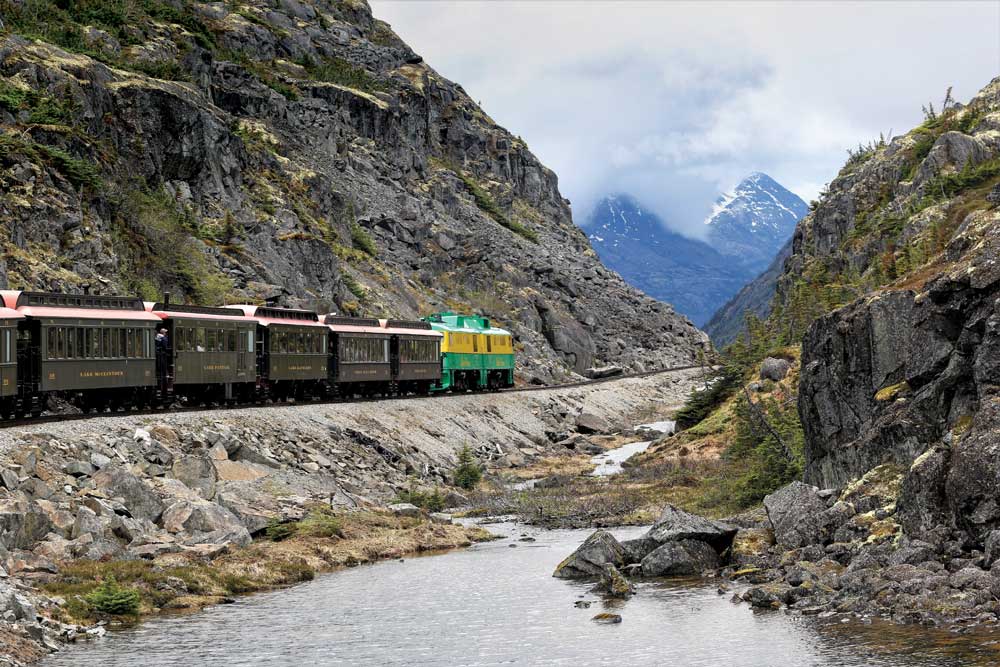
Klondike Rail: Vintage railcars chug from Skagway to the summit of White Pass on the 1898 narrow-gauge line to the goldfields.
We drive north to Clover Pass Resort, a fishing resort with RV spaces, motel rooms, a dining room and marina. After pulling into our waterfront site, we watch eagles dive from treetop perches, as camp chef Sandy fills our bellies with hearty spaghetti and Parmesan chicken. Then we fall into bed, lulled by the sound of water lapping against the docks.
We’re up early to fish with Clover Pass Resort’s Michael Briggs aboard a 20-foot covered aluminum boat with a fast engine. Michael doesn’t guide but regularly fishes these waters. While Ketchikan is known as the Salmon Capital of the World, this year’s run is spotty, and we catch only rockfish. The next day, Anne and I rent an open 14-foot skiff, and using Michael’s rigging tricks, land a nice-size pink salmon.
In the morning we drive to Salmon Falls Fishing Resort, featuring an upscale dining room. While Salmon Falls doesn’t offer RV camping, we want to experience a fully guided all-day fishing trip. Anne lands a silver salmon, but I am not so lucky. Before returning to Clover Pass, I drown my fishing woes in the dining room with delicious crab legs and king salmon.
The next morning, while packing for the ferry, we hear “whoosh!” Five humpback whales steam by the docks, undulating in and out of the water, tails and flukes high, a fitting Ketchikan farewell.
Journey to Juneau
After busy days in Ketchikan, we board the afternoon ferry to Juneau, and I’m looking forward to the leisurely overnight trip.
Arriving to fair skies the next morning, we park in a public lot and head up the Mount Roberts Tramway for spectacular views of downtown, Gastineau Channel and snowcapped mountains. We hike shady trails, explore the gift shop and talk with native Tlinglit artists.
To learn more about those humpbacks we spotted in Ketchikan, we board the Gastineau Guiding whale-watch boat. Our guide says Alaska’s 100,000 glaciers provide minerals to feed phytoplankton, which feed the fish that bring the whales. Humpbacks can be as long as a school bus and weigh 80,000 pounds. Our first humpback is a small female who repeatedly rolls and lunge feeds at the surface, giving us good views.
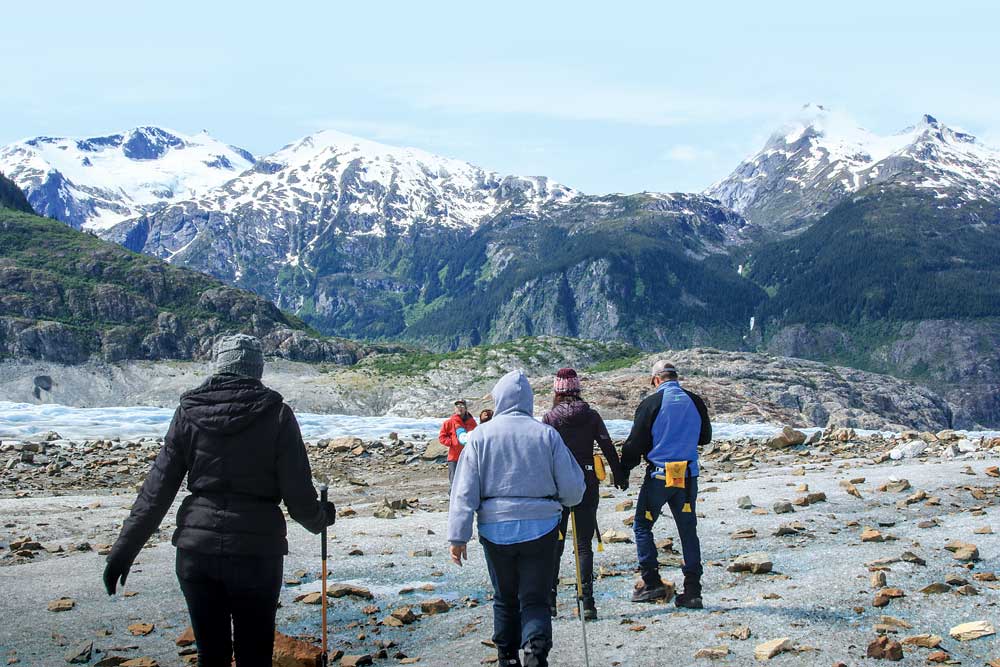
On the Glacier Discovery Tour, a 20-minute helicopter flight transports tour-takers from Skagway to the remote “ice river” known as Meade Glacier.
“Black-and-whites!” the captain shouts. He’s spotted orcas — a large male, a half-dozen females and a baby. Orcas actually belong to the dolphin family, but they get the “killer whale” name from their tag-team hunting techniques. We watch this pod cavort, their tall dorsal fins and white side spots visible.
Later, we drive to Spruce Meadow RV Park, pull into a shady, gravel-topped site and tuck in early.
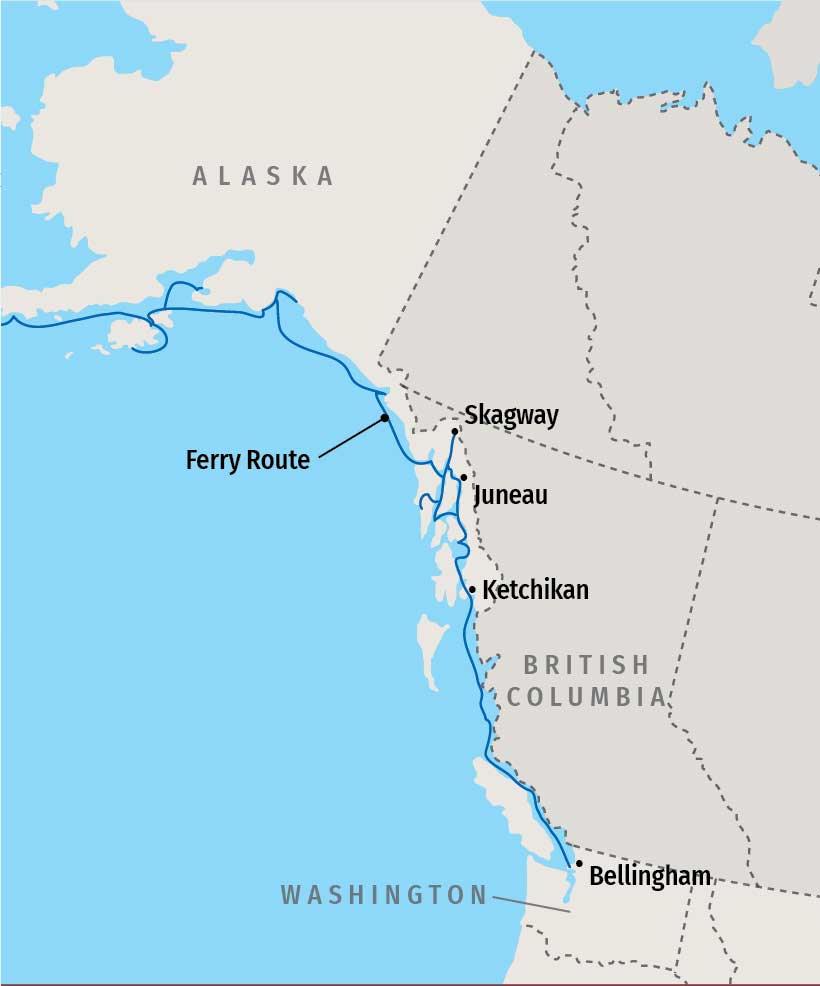
Alaska Ferry
Alaska encompasses 650,000 square miles, and much of it is without roads. The Alaska ferry is a big part of the state’s “highway system” and is designed for transportation; sightseeing is a bonus. Its route has been designated a National Scenic Byway and an All-American Road, and it is the only marine corridor with this distinction.
The ferry lets RVers get off the beaten path and explore lesser-known communities like Native Alaskan villages that are impossible or too time-consuming to reach on the road. Passengers can view gorgeous scenery and watch for whales without the crowds or fussiness of a floating cruise resort.
AMHS ferries are basic, clean and comfortable. In addition to cabins, many offer a movie theater, arcade, reading room, kids’ playroom, public showers and restrooms, plus indoor and outdoor observation decks. The vessels also serve hot and cold food, and the flagship MV Columbia has a restaurant dining room. Guests also have access to hot water, a toaster, a microwave, ice and vending machines.
While the ferry is under way, passengers aren’t allowed on the vehicle deck except during scheduled times. Pets must remain in the owner’s vehicle and can be visited every eight hours. Be aware that the vehicle deck can be noisy, and for anxious pets the experience may be frightening.
Alaska Marine Highway System
The weather is cool and drizzly the next morning when we meet Terri, our Juneau Food Tours guide, for a taste of Alaska. First stop is Tracy’s King Crab Shack, a Juneau institution, for crisp mini-crab cakes and creamy crab bisque. Then on to Deckhand Dave’s for panko-crusted salmon. My favorite stop is McGivney’s Sports Bar and Grill where we savor Hog Wings, sweet-crispy pork shanks. At Salt fine-dining restaurant, we sample halibut dumplings, and finish up with a local-beer flight at the historic Alaskan Hotel.
We walk off some calories by cruising the docks. Like Ketchikan, Juneau has plenty of souvenir shops.
My favorite landmark is the whale sculpture on West Eighth Street next to Douglas Bridge. Commissioned to celebrate the state’s 100th anniversary, Tahku is a life-size bronze humpback leaping 25 feet high with water cascading off her flukes.
After a peaceful evening at Spruce Meadow, we drive to Mendenhall Glacier, a rare car-accessible glacier. We hike a trail to view Mendenhall Lake and the ice river’s blue face, and follow elevated wooden walkways through muskeg and forest. In the visitor center, we learn that Juneau Icefield feeds 38 glaciers and that the snow takes 200 years to get to the glacier and the lake. There’s also a dramatic time-lapse video that shows how much the glacier has retreated.
In the afternoon, we meet the Local Guy Charters and Sightseeing crew for fishing. Our three-hour troll yields two king salmon — a red and a rare white — and we’re thrilled.
Skagway Bound
We’re on the early ferry to Skagway, famous as the gateway to the Klondike goldfields. It’s a two-and-a-half-hour cruise, and the ferry drops us downtown. We park the Pleasure-Way on a level, gravel-topped site at Pullen Creek RV Park. The campground, one of the nicest on this trip, sits across from a leafy city park, and offers water and electric hookups but no Wi-Fi.
With false-fronted buildings and wooden sidewalks, Skagway resembles a Western-movie set. We poke into shops and check out the City of Skagway Museum’s old photos and exhibits on rail history and period fashions.
We lunch at Jewell Gardens and Glass, a historic show garden, and join Head Gardener Randy and Assistant Director Josie for lunch at Poppies Restaurant. As I tuck into delectable halibut cakes and Anne enjoys duck confit salad, Randy tells us this garden fed Klondike Gold Rush travelers.
In 1997 Charlotte Jewell reclaimed the space for an organic show garden. After touring the garden’s flowers, herbs and vegetables, we head to the glass-blowing studio. We don white coats and safety glasses, and instructor Travis leads us through selecting colors and styles for our globes, gathering glass on long rods, twirling them in the furnace and finally blowing through a long pipe to inflate them. Travis places our beautiful orbs in a cooling chamber for 12 hours and promises to mail them to us.
We’re intrigued by Skagway’s colorful history, so we stop at the Gold Rush Cemetery, a well-kept burial ground used from 1898 to 1908 for Skagway residents, including infamous con man Soapy Smith. In the evening, we take in Days of ’98, a rollicking musical about the city’s past.
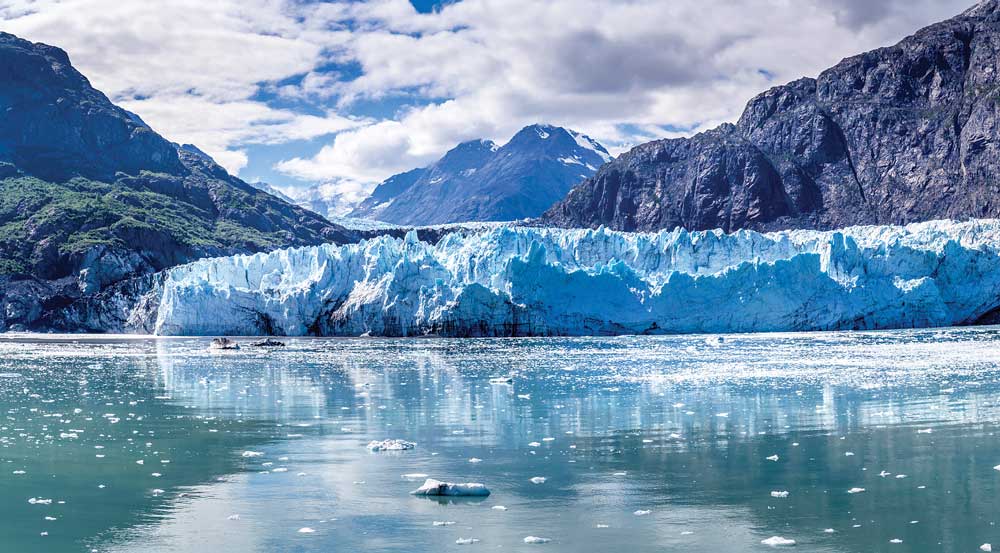
Shaped by glaciers over the millennia, the Inside Passage to Alaska is a 1,000-mile-long natural wonder. With plenty of time to enjoy the view, ferry passengers can appreciate the ever-changing panorama.
The next morning, our last before heading back on the ferry, we board vintage passenger coaches on the White Pass and Yukon Route Railway. This narrow-gauge line, built in 1898, became the primary route to the Klondike goldfields. We’ve chosen the three-and-a-half-hour excursion that retraces the original route to White Pass Summit.
The train chugs past silty Skagway River, through valleys dotted with orange columbine, purple lupine and yellow yarrow, and under glaciers and cloud-topped mountains. As we pass Bridal Veil Falls, Inspiration Point and Dead Horse Gulch, eager photographers gather outside on covered platforms. The train goes by the original Klondike Trail of ’98, worn into the rocks, and we spot rusted metal cans and an old shovel head, as we imagine the thousands of miners that trudged up this trail.
After lunch back in Skagway, we head to Temsco Helicopters for our final adventure, the Glacier Discovery Tour. We don glacier boots and climb aboard the ’copter for a 20-minute flight to Meade Glacier, one of the largest, where the pilot smoothly sets down. With hiking poles in hand, we follow glacier guide David over the rippled surface. He says the 500-year-old ice came from the Juneau Icefield 50 miles away. The cracks and crevasses we hop over wink like blue diamonds.
David invites us to drink from a rushing glacier stream. The water is icy and delicious, the perfect toast to our Alaska ferry adventure.
RVs on Board
Alaska Marine Highway System ferries can accommodate RVs of all sizes, and parking crews are masters at loading and unloading large vehicles. Fares are based on where you’re going, whether or not you book a cabin and the size of your rig. Before making reservations, you’ll need to measure your RV from the front bumper of the tow vehicle to the rear bumper of the trailer, and from side to side with the mirrors folded.
Worth Noting:
There is no Wi-Fi on AMHS ferries. To pass the time, people read, talk, play games, watch movies, write in journals and enjoy the scenery.

